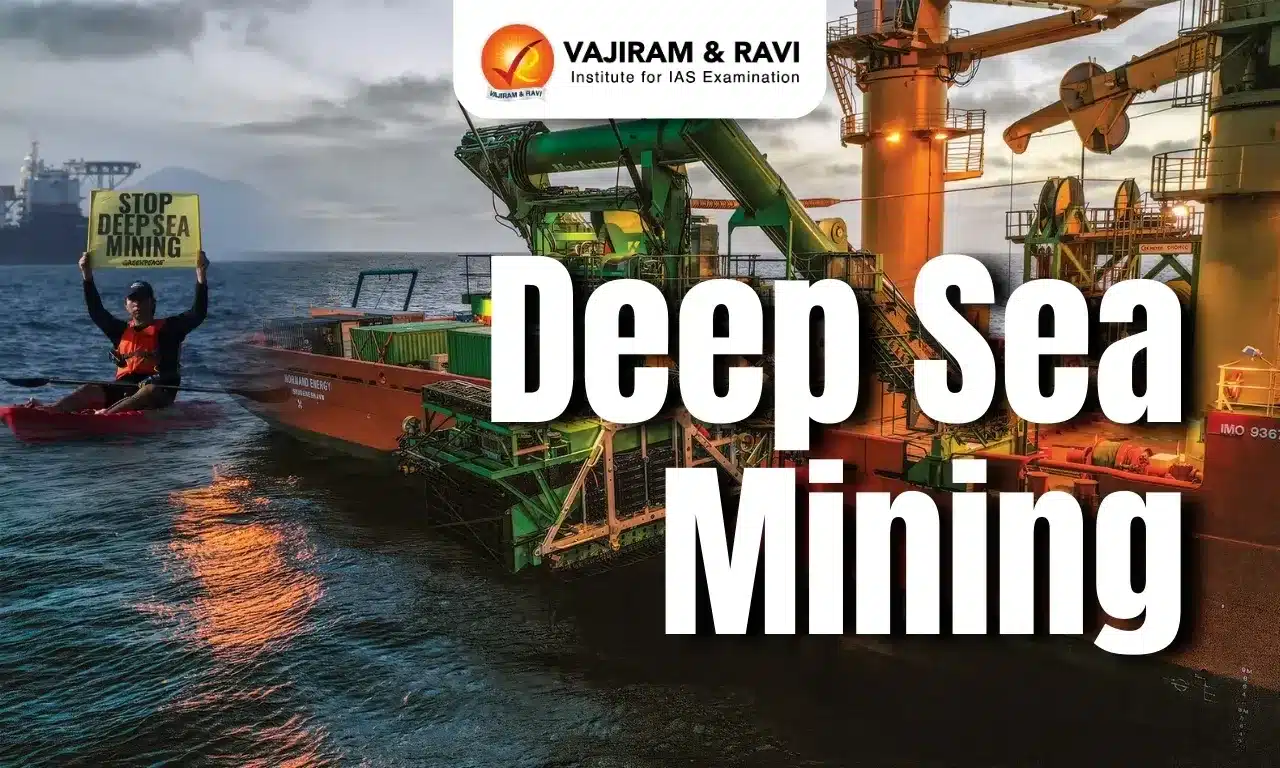Deep Sea Mining Latest News
A new study published in Nature titled “Long-term Impact and Biological Recovery in a Deep-Sea Mining Track” has revealed that a strip of the Pacific Ocean seabed mined over 40 years ago has still not recovered.
Why in the News?
- The study, conducted by Britain’s National Oceanography Centre, found long-term sediment changes and a decline in populations of larger organisms in the mined area.
- This comes amid growing global calls for a moratorium on deep sea mining, with 36 countries recently discussing the issue at a United Nations International Seabed Authority meeting in Jamaica.
What is Deep Sea Mining?
Deep sea mining involves the extraction of mineral deposits and metals from the ocean seabed. It is categorized into three types:
|
Type of Deep Sea Mining |
Process |
Key Minerals Extracted |
|
Polymetallic Nodule Mining |
Collecting mineral-rich nodules from the ocean floor |
Nickel, Cobalt, Rare Earths |
|
Seafloor Massive Sulphide Mining |
Extracting metal deposits from hydrothermal vents |
Gold, Silver, Copper, Zinc |
|
Cobalt-Rich Crust Mining |
Stripping cobalt crusts from underwater mountains |
Cobalt, Platinum, Manganese |
- These minerals are crucial for battery production, renewable energy technologies, and electronics like mobile phones and computers.
- Mining technology is still evolving, with companies developing:
- Massive pumps to vacuum materials from the seabed
- AI-based deep-sea robots to extract nodules
- Advanced machinery for mining near underwater mountains and volcanoes
- Governments and corporations view deep sea mining as a strategic necessity due to depleting onshore reserves and increasing demand for critical minerals.
International Seabed Authority (ISA)
- About ISA
- Established under the 1982 United Nations Convention on the Law of the Sea (UNCLOS).
- Came into force in 1994 and became fully operational in 1996.
- Headquarters – Kingston, Jamaica.
- Functions of ISA
- Regulates and manages mineral-related activities in international seabed areas beyond national jurisdiction.
- Grants licenses for deep-sea exploration and mining.
- Ensures environmental protection while overseeing resource utilization.
- ISA recently held a council meeting with 36 countries to discuss whether mining companies should be allowed to extract minerals from the ocean floor.
Deep Sea Mining FAQs
Q1. What is Deep Sea Mining?
Ans. It is the extraction of minerals and metals from the ocean floor, including polymetallic nodules, sulphides, and cobalt-rich crusts.
Q2. Which international body regulates Deep Sea Mining?
Ans. The International Seabed Authority (ISA) under UNCLOS (United Nations Convention on the Law of the Sea).
Q3. Why is Deep Sea Mining controversial?
Ans. It poses environmental risks such as habitat destruction, biodiversity loss, and disruption of oceanic ecosystems.
Q4. What are India’s efforts in Deep Sea Mining?
Ans. India is developing deep-sea mining technology under the Deep Ocean Mission and has an exploration contract with the ISA for polymetallic nodules in the Central Indian Ocean Basin.
Source: IE
Last updated on January, 2026
→ Check out the latest UPSC Syllabus 2026 here.
→ Join Vajiram & Ravi’s Interview Guidance Programme for expert help to crack your final UPSC stage.
→ UPSC Mains Result 2025 is now out.
→ UPSC Notification 2026 is scheduled to be released on January 14, 2026.
→ UPSC Calendar 2026 is released on 15th May, 2025.
→ UPSC Prelims 2026 will be conducted on 24th May, 2026 & UPSC Mains 2026 will be conducted on 21st August 2026.
→ The UPSC Selection Process is of 3 stages-Prelims, Mains and Interview.
→ UPSC Result 2024 is released with latest UPSC Marksheet 2024. Check Now!
→ UPSC Toppers List 2024 is released now. Shakti Dubey is UPSC AIR 1 2024 Topper.
→ Also check Best IAS Coaching in Delhi

















